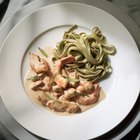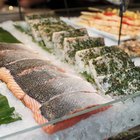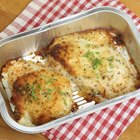
It's always a red-letter day when you catch a great sale on pork chops or other family favorites. It's even better if you have enough freezer space to take full advantage of the low price. Of course, it means you'll need to plan your meals far enough ahead to thaw the chops before you use them. Ideally you'd do that overnight in your refrigerator -- the safest method -- but if you forget, there are quicker ways to defrost.
Microwave Defrosting
Your microwave oven is probably the fastest way to defrost pork chops, but it does present a few practical problems. For one thing, the defrost function's effectiveness varies wildly between brands and models. More importantly, microwaves heat unevenly. Turn your chops frequently to ensure that they thaw evenly, and separate them as soon as possible if they're stacked. They'll thaw more evenly in a single layer. If your microwave tends to cook one section of the chop and leave others frozen, interrupt the defrost cycle periodically by opening the door, and let the chops sit for five minutes so their temperatures can equalize.
Cold Water Defrosting
For small packages of chops or individual chops, cold water defrosting can be as quick as microwave defrosting. Place the tightly wrapped chops in a deep bowl and fill it with cold water. Change the water after 20 to 30 minutes, or leave cold water trickling into it so it's constantly refreshed. Individual chops can thaw this way in 20 to 40 minutes, depending on their thickness, while packages of chops can take an hour or more. If the chops are stacked, separate and refrigerate the top and bottom chops as soon as they're thawed, then rewrap and continue thawing the remainder.
Food Safety Tips
When you're thawing chops or any other food, it's important to observe good food-handling practices. Never thaw foods at room temperature, which encourages bacterial growth. Microwave thawing always raises at least part of your chop into the food-safety "danger zone" between 40 degrees and 140 degrees Fahrenheit. Microwave-thawed foods need to be cooked immediately to remain food safe. For water thawing, use the two-hour rule. Foods are generally safe at room temperature for up to two hours, so keep your thawing time within that limit. Wash your hands, utensils and work surfaces with hot, soapy water before switching from meats to other foods. That minimizes the risk of cross-contamination between foods.
Packaging Tips
Any time you have pork chops to freeze, follow a few simple tips for trouble-free freezing and thawing. Always package the chops in a single layer, which enables them to freeze and thaw more quickly. This ensures that they spend less time in the food safety "danger zone." When your freezer space is limited, freeze the chops individually and bag them together, with parchment or wax paper in between, so they can be easily separated. Ensure that the packaging is airtight, both to preserve their quality in the freezer and to minimize leaking juices when they're thawed.
Related Articles

Can You Cook Frozen Foods That Are Past ...

Food Safety Tips for Frozen Pork
How to Thaw, Cook & Refreeze Vegetables

Do You Thaw Hamburger Patties Before ...
How Long Do Thawed Pork Chops Stay ...

Can You Refreeze Shrimp That Has Been ...

FDA Food Storage Temperature Guidelines
Can We Refreeze Frozen Vegetables?
Can I Freeze Pork Immediately After ...

The Best Containers for Homemade TV ...

Rules for Thawing and Refreezing Meat

How Long Is Leftover Spaghetti Good to ...

How Long Do I Cook Frozen Package ...

Guidelines For Refreezing

Perfect Way to Cook a Pork Chop in the ...

Can You Defrost Hamburger in Hot Water?

Do Pork Chops Stay Good When Frozen?

Cooking Frozen Vs. Defrosted Food

Do You Need to Defrost Chicken Wings ...
Can Swedish Meatballs Be Frozen Until ...
References
Writer Bio
Fred Decker is a trained chef and prolific freelance writer. In previous careers, he sold insurance and mutual funds, and was a longtime retailer. He was educated at Memorial University of Newfoundland and the Northern Alberta Institute of Technology. His articles have appeared on numerous home and garden sites including GoneOutdoors, TheNest and eHow.
Photo Credits
Jupiterimages/Comstock/Getty Images